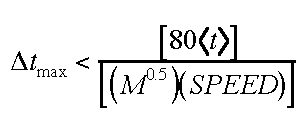
TIME DERIVATIVE ANALYSIS
How to choose the time interval and maximum number of scans to analyze.
A
rule of thumb (i.e. approximate rule) for choosing the maximum number of scans to analyze is the following:The time difference,
Dt, between the first and the last scan used should not exceed the following value:
where < t > is the average of the times for first and last scan. M is the molecular weight expressed in Kg/mole and SPEED is the angular velocity of the rotor expressed in units of (RPM/1000).
This can be expressed more handily as

where now <
w2t> in the numerator is the average of the values of w2t (found on the second line of the XL-A/XL-I output files) for the first and last scans to be included in the data set, and Dw2t is the difference of the values of w2t for the last and first scans.This rule of thumb is based on the restriction that a gaussian boundary located about 0.5 cm from the meniscus not be allowed to move more than 0.5 standard deviation during the time interval
Dtmax/2 which is the time interval between the scans being subtracted to generate dc/dt. Simulations have shown that this gives generally satisfactory results (i.e. minimal artificial dispersion in the g(s*) curve) for determination of diffusion coefficients from the standard deviation of the peak . The factor of 80 in the numerator may adjusted to taste. For ordinary analysis, not involving estimation of diffusion coefficients, the time interval may be doubled without introducing serious dispersion. This will afford about 40% improvement in the signal-to-noise. The actual number of scans to use over that time interval will depend on the optical system and the number of cells being run.Walter Stafford
BBRI
4/13/2001